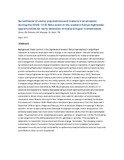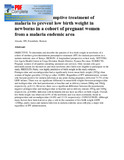Parasites and vectors of malaria on Rusinga Island, Western Kenya

View/
Date
2015Author
Olanga, Evelyn A
Okombo, Lawrence
Irungu, Lucy W
Mukabana, Wolfgang R
Language
enMetadata
Show full item recordAbstract
Background There is a dearth of information on malaria endemicity in the islands of Lake Victoria in western Kenya. In this study malaria prevalence and Plasmodium sporozoite rates on Rusinga Island were investigated. The contribution of different Anopheles species to indoor and outdoor transmission of malaria was also determined. Methods Active case detection through microscopy was used to diagnose malaria in a 10% random sample of the human population on Rusinga Island and a longitudinal entomological survey conducted in Gunda village in 2012. Nocturnally active host-seeking mosquitoes were captured indoors and outdoors using odour-baited traps. Anopheles species were tested for the presence of Plasmodium parasites using an enzyme linked immunosorbent assay. All data were analyzed using generalized linear models. Results Single infections of Plasmodium falciparum (88.1%), P. malariae (3.96%) and P. ovale (0.79%) as well as multiple infections (7.14%) of these parasites were found on Rusinga Island. The overall malaria prevalence was 10.9%. The risk of contracting malaria was higher among dwellers of Rusinga West than Rusinga East locations (Odds Ratio [OR] = 1.5, 95% Confidence Interval [CI] 1.14 – 1.97, P = 0.003). Parasite positivity was significantly associated with individuals who did not use malaria protective measures (OR = 2.65, 95% CI 1.76 – 3.91, p < 0.001). A total of 1,684 mosquitoes, including 74 anophelines, were captured. Unlike Culex species, more of which were collected indoors than outdoors (P < 0.001), the females of An. gambiae s.l. (P = 0.477), An. funestus s.l. (P = 0.153) and Mansonia species captured indoors versus outdoors were not different. The 46 An. gambiae s.l. collected were mainly An. arabiensis (92.3%). Of the 62 malaria mosquitoes tested, 4, including 2 indoor and 2 outdoor-collected individuals had Plasmodium. Conclusion The rather significant and unexpected contribution of P. malariae and P. ovale to the overall malaria prevalence on Rusinga Island underscores the epidemiological importance of these species in the big push towards eliminating malaria. Although current entomological interventions mainly target indoor environments, additional strategies should be considered to prevent outdoor transmission of malaria.
URI
http://www.parasitesandvectors.com/content/pdf/s13071-015-0860-z.pdfhttp://hdl.handle.net/11295/82035
Citation
Olanga,Evelyn A., Okombo, Lawrence ., Irungu, Lucy W., Mukabana,Wolfgang R (2015).Parasites and vectors of malaria on Rusinga Island, Western KenyaPublisher
university of nairobi
Collections
- Faculty of Health Sciences (FHS) [10415]
- Journal Articles [329]
Related items
Showing items related by title, author, creator and subject.
-
Implementation of Community Case Management of Malaria in Malaria Endemic Counties of Western Kenya: Are Community Health Volunteers Up to the Task in Diagnosing Malaria?
Marita, Enock; Langat, Bernard; Kinyari, Teresa; Igunza, Patrick; Apat, Donald; Kimori, Josephat; Carter, Jane; Kiplimo, Richard; Muhula, Samuel (University of Nairobi, 2022)Background: Community case management of malaria (CCMm) is an equity-focused strategy that complements and extends the reach of health services by providing timely and effective management of malaria to populations with ... -
Surveillance of vector populations and malaria transmission during the 2009/10 El Niño event in the western Kenya highlands: opportunities for early detection of malaria hyper-transmission
Ototo, EN; Githeko, AK; Wanjala, CL; Scott, TW (College of Health Sciences, University of Nairobi, 2011)Background: Vector control in the highlands of western Kenya has resulted in a significant reduction of malaria transmission and a change in the vectorial system. Climate variability as a result of events such as El Niño ... -
Intermittent presumptive treatment of malaria to prevent low birth weight in newborns in a cohort of pregnant women from a malaria endemic area
Alusala, DN; Estambale, Benson (University of Nairobi.Department of Medical Microbiology, 2009-08)OBJECTIVE: To determine and describe the patterns of low birth weight in newborns of a cohort of mothers given intermittent presumptive treatment (IPT) for malaria prevention in a malaria endemic area of Kenya. DESIGN: A ...



